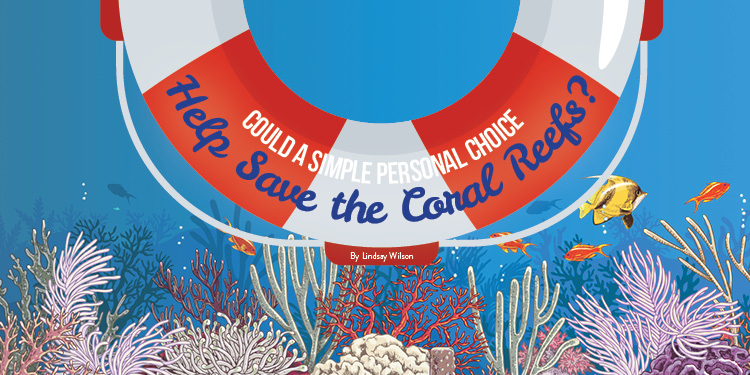


Sign-up for {N}power to get exclusive discounts, newsletters, members-only features, and more!
 Denver - Design District - Alameda and Broadway
Denver - Design District - Alameda and Broadway
368 S Broadway
Denver, CO 80209
United States
 Preferred Store:
Select a Store
Preferred Store:
Select a Store


Imagine a vibrant world hidden beneath the ocean surface, a world teeming with life; a veritable forest of coral that houses sea sponges, sea turtles, sharks, crabs, lobsters, seahorses, and fish in a shocking array of colors. The world’s coral reefs make up a tiny fraction of the ocean, but support a quarter of all marine life, rivaling rainforests in their unique biodiversity. According to the National Oceanic and Atmospheric Administration (NOAA), every year coral reefs add $3.4 billion to the U.S. economy through tourism, seafood, and medicine. The world’s reefs are also crucial for protecting vulnerable coastlines by reducing storm surge and erosion from waves. But around the world, reefs are in trouble, with some researchers predicting that virtually all tropical coral reefs will be at risk of “severe degradation” by 2050. The biggest threats to coral reefs are climate change, harmful fishing practices, and pollution, and while admittedly, those are immense problems to tackle, there is something that every one of us can do at the individual level, starting this summer!
One of the most ubiquitous chemicals found in sunscreens, oxybenzone (also known as benzophenone-3), has been shown to cause deformities in coral larvae and cause young coral to encase themselves in their own skeletons; cause coral bleaching (a prime cause of coral death); trigger viral infections in coral; and lead to DNA damage that weakens the coral’s ability to adapt to climate change. The chemical can be damaging even in minuscule amounts—a recent study conducted by a team of international researchers found that oxybenzone can damage coral in concentrations as low as 62 parts per trillion, comparable to one drop in six and a half Olympic-sized swimming pools. Seawater samples taken in the study showed concentrations 12 times higher than that in Hawaii and the Caribbean, both areas with large numbers of sunscreen-slathered tourists, and the researchers observed more severe damage to reefs in these areas compared to more isolated reefs. All told, up to 14,000 tons of sunscreen is estimated to be released into coral reef areas each year, putting about 40 percent of reefs located near coastal areas at risk of exposure. And it’s not just swimmers and snorkelers shedding sunscreen into the water. Even if you live hundreds of miles from the ocean, if you wear chemical sunscreens at the pool, the river, the lake, or even in your facial moisturizer, it will wash off of you and eventually make its way to the ocean.
It’s all about the sunscreen — ditch the chemical-based ones and replace them with reef-friendly mineral sunscreen.
If oxybenzone is harmful to coral and other marine species, could it affect humans? Turns out, it does. Oxybenzone is absorbed into the body through the skin and acts as an endocrine disruptor, altering reproductive and hormone function. It has been shown to have an estrogenic and antiandrogenic effect in mammals and is also associated with an increased occurrence of endometriosis in women. The chemical also creates damaging free radicals in the skin when exposed to UV light, causing oxidative damage to our cells. And most of us are contaminated with the stuff. A study conducted by the Centers for Disease Control (CDC) tested 2,500 Americans, age six and up, and found that 97 percent had oxybenzone in their urine. Other studies have found similar results, and one study found that volunteers continued to excrete oxybenzone many days after the last application, an indication that it accumulates in fatty tissues.
The last safety review of oxybenzone was done in the 1970s. Since then, the Food and Drug Administration (FDA) has made no move to update sunscreen safety standards, despite a body of new research on the chemical and its effects on both marine life and humans.
Research has clearly shown that oxybenzone is no good for living things, including coral or people, but we all want to protect our skin from the burning rays of the sun and the potential damage they can cause, so what are the alternatives? Steer clear of the chemicals and choose mineral-based sunscreens like zinc oxide and titanium dioxide, which stay on top of the skin and physically block UV rays, and look for water-resistant varieties that won’t immediately wash off in the water. UV-blocking swimwear and other clothing is also an option. And finally, protect yourself from the inside out with antioxidants like astaxanthin, lutein, lycopene, and vitamins C and E to reinforce your skin’s natural defenses against UV damage. Just remember that these should be taken long-term to provide adequate protection (i.e., don’t take one dose of astaxanthin and go bake in the sun for six hours!).
Background pollutants like oxybenzone make coral less resilient and unable to bounce back from larger events like warming ocean water. While saving the world’s coral reefs might sound overwhelming, there is a little part each one of us can play in a simple choice we make before hitting the beach (or the pool, or lake…). Say no to oxybenzone (and other chemical sunscreens) and choose a coral-reef safe sunscreen!
While oxybenzone is the most pervasive and well-studied of the chemical sunscreens, there are others to be wary of. According to the Environmental Working Group (EWG), chemical sunscreens like octinoxate and homosalate also have hormone-like activity, may affect the reproductive system, and disrupt the normal activity of hormones like estrogen and progesterone. Natural Grocers phased out all chemical sunscreens in 2015 and is committed to only selling mineral-based sunscreen. Visit your local Natural Grocers for more information on how to make healthy sunscreen choices to protect yourself, your family, and the coral reefs.



Sign-up for {N}power to get exclusive discounts, newsletters, members-only features, and more!
